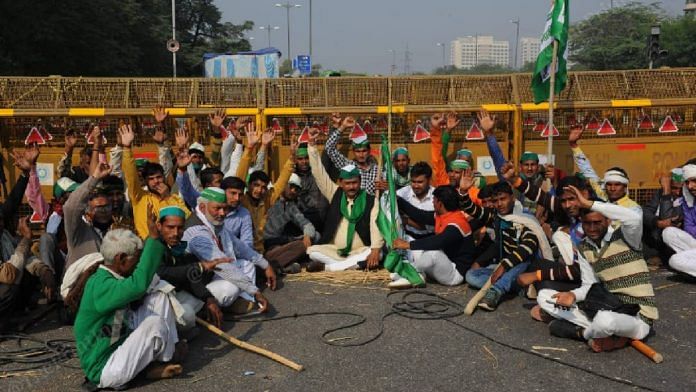New Delhi: The central government and farmer unions are holding talks once again Saturday even as protesting farmers declared a nationwide shutdown.
At the centre of their protests are two issues — the fear that Minimum Support Price (MSP) will not be enforced once private mandis come up and the amendment of the Agricultural Produce Marketing Committee (APMC) Act.
In episode 633 of ‘Cut The Clutter‘, ThePrint’s Editor-in-Chief Shekhar Gupta explains what MSP and APMC are, their intricacies and why there’s a need for crop diversification.
Where do APMC & MSP come from
APMC Act-like laws were first enacted under the British who wanted colonies to grow cheap raw material like cotton for their factories in Britain.
“So government agents or government-appointed agents or commission agents, or middlemen would buy it. And together they will cartelize or government will declare a price. And they’ll keep the price to a certain level,” Gupta said.
Meanwhile, the MSP was “India’s response to the old tradition of price controls”.
Price controls in India, Gupta explained, go back to the time of Alaudin Khilji who was a confiscatory ruler. But along with imposing a tough taxation system with heavy penalties, Khilji also introduced price controls on agricultural commodities.
The reason — “He wanted his soldiers who were of Turkic origin and living in garrisons outside big cities…to get grain at a cheaper price”, Gupta said.
Also read: Punjab’s frustration & anger is rooted in its steep decline, now visible in farmers’ protests
US’s ‘good pressure’
In the 1960s, India was experiencing massive food shortages and, as a result, became dependent on imported grain. This brought about the green revolution, that brought in new technologies with the help of the US.
The grain assistance was coming to India as a part of the scheme called PL480. As a result, “America got some leverage over India,” Gupta said.
Also, since the political and economic situation in India was unstable at the time, the US government, under President Lyndon Johnson, was able to apply “good pressure”, and persuaded the Indian government to move away from price control, Gupta said.
“They [Lyndon Johnson government] said as long as you have price controls you are giving no incentive to your farmer to produce more…So MSP was also expected to suppose to protect the farmer from sudden crashes and market price,” he added.
At the same time, in Punjab, Mohinder Singh Randhawa along with Norman Borlaug and M.S. Swaminathan came up with new varieties of wheat. As a result of these shifts, Gupta said, farmers took to agriculture and “India’s wheat production doubled”.
The agricultural boom first took place in Punjab, followed by Haryana and then other states. Also, along with wheat, paddy cultivation also increased.
MSP now a ‘liability’
The MSP regime, however, has pushed Punjab and Haryana into “self-destructive paddy and wheat cycles”.
“What’s happening is that MSP which was supposed to incentivise the farmer to invest in inputs and to adopt technologies has now become a liability because it’s now made the agricultural economy lazy,” he said.
Gupta highlighted how India’s buffer stock of wheat and rice was 97 million tonnes in June as opposed to the required 41.2 million tonnes.
“So what’s happening is that government of India, Food Corporation of India is buying this stuff because there is an MSP and farmers have no incentive to switch to anything else or to diversify their farming practices,” he said.
Also read: Thatcher or Anna moment? Why Modi’s choice on farmers’ protest will shape future politics
Why the reforms
The three agricultural reforms essentially address India’s excess grain problem. “If private markets come in, if contract farming happens, then some people might move to vegetables, oil, seeds, pulses,” Gupta said.
Currently, India spends $10 billion a year in procuring vegetable oils, edible oils and oilseeds.
In addition to this, the reforms are also to level the playing field especially for states where the APMC Act was abolished. Gupta explained that grain sold through the National Food Security Act for a subsidised price from the surplus states in Bihar “ends up depressing the markets”.
Beyond this, the incomes of farmers in the states producing the surplus crop aren’t rising. “The farmers’ income is not going up because procurement price can only go by 4 per cent or 5 per cent,” he further said.
He concluded by saying that if “more and more farmers in Punjab and Haryana could be persuaded to shift from wheat and rice…it will be good for India, its trade balance and the overall pricing situation.”
“But to make a shift…you cannot do it by coercion. You have to do it by persuasion,” he added.
Watch the latest episode of CTC here:



